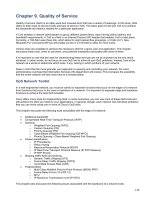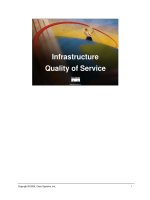Chapter 24 Congestion Control and Quality of Service pdf
Bạn đang xem bản rút gọn của tài liệu. Xem và tải ngay bản đầy đủ của tài liệu tại đây (912.36 KB, 48 trang )
24.1
Chapter 24
Congestion Control and
Quality of Service
Copyright © The McGraw-Hill Companies, Inc. Permission required for reproduction or display.
24.2
24-1 DATA TRAFFIC
24-1 DATA TRAFFIC
The main focus of congestion control and quality of
The main focus of congestion control and quality of
service is
service is
data traffic
data traffic
. In congestion control we try to
. In congestion control we try to
avoid traffic congestion. In quality of service, we try to
avoid traffic congestion. In quality of service, we try to
create an appropriate environment for the traffic. So,
create an appropriate environment for the traffic. So,
before talking about congestion control and quality of
before talking about congestion control and quality of
service, we discuss the data traffic itself.
service, we discuss the data traffic itself.
Traffic Descriptor
Traffic Profiles
Topics discussed in this section:
Topics discussed in this section:
24.3
Figure 24.1 Traffic descriptors
24.4
Figure 24.2 Three traffic profiles
24.5
24-2 CONGESTION
24-2 CONGESTION
Congestion in a network may occur if the load on the
Congestion in a network may occur if the load on the
network—the number of packets sent to the network—
network—the number of packets sent to the network—
is greater than the capacity of the network—the
is greater than the capacity of the network—the
number of packets a network can handle. Congestion
number of packets a network can handle. Congestion
control refers to the mechanisms and techniques to
control refers to the mechanisms and techniques to
control the congestion and keep the load below the
control the congestion and keep the load below the
capacity.
capacity.
Network Performance
Topics discussed in this section:
Topics discussed in this section:
24.6
Figure 24.3 Queues in a router
24.7
Figure Packet delay and throughput as functions of load
24.8
24-3 CONGESTION CONTROL
24-3 CONGESTION CONTROL
Congestion control refers to techniques and
Congestion control refers to techniques and
mechanisms that can either prevent congestion, before
mechanisms that can either prevent congestion, before
it happens, or remove congestion, after it has
it happens, or remove congestion, after it has
happened. In general, we can divide congestion
happened. In general, we can divide congestion
control mechanisms into two broad categories: open-
control mechanisms into two broad categories: open-
loop congestion control (prevention) and closed-loop
loop congestion control (prevention) and closed-loop
congestion control (removal).
congestion control (removal).
Open-Loop Congestion Control
Closed-Loop Congestion Control
Topics discussed in this section:
Topics discussed in this section:
24.9
Figure 24.5 Congestion control categories
24.10
Figure 24.6 Backpressure method for alleviating congestion
24.11
Figure 24.7 Choke packet
24.12
24-4 TWO EXAMPLES
24-4 TWO EXAMPLES
To better understand the concept of congestion
To better understand the concept of congestion
control, let us give two examples: one in TCP and the
control, let us give two examples: one in TCP and the
other in Frame Relay.
other in Frame Relay.
Congestion Control in TCP
Congestion Control in Frame Relay
Topics discussed in this section:
Topics discussed in this section:
24.13
Figure 24.8 Slow start, exponential increase
24.14
In the slow-start algorithm, the size of
the congestion window increases
exponentially until it reaches a
threshold.
Note
24.15
Figure 24.9 Congestion avoidance, additive increase
24.16
In the congestion avoidance algorithm,
the size of the congestion window
increases additively until
congestion is detected.
Note
24.17
An implementation reacts to congestion
detection in one of the following ways:
❏ If detection is by time-out, a new slow
start phase starts.
❏ If detection is by three ACKs, a new
congestion avoidance phase starts.
Note
24.18
Figure 24.10 TCP congestion policy summary
24.19
Figure 24.11 Congestion example
24.20
Figure 24.12 BECN
24.21
Figure 24.13 FECN
24.22
Figure 24.14 Four cases of congestion
24.23
24-5 QUALITY OF SERVICE
24-5 QUALITY OF SERVICE
Quality of service (QoS) is an internetworking issue
Quality of service (QoS) is an internetworking issue
that has been discussed more than defined. We can
that has been discussed more than defined. We can
informally define quality of service as something a
informally define quality of service as something a
flow seeks to attain.
flow seeks to attain.
Flow Characteristics
Flow Classes
Topics discussed in this section:
Topics discussed in this section:
24.24
Figure 24.15 Flow characteristics
24.25
24-6 TECHNIQUES TO IMPROVE QoS
24-6 TECHNIQUES TO IMPROVE QoS
In Section 24.5 we tried to define QoS in terms of its
In Section 24.5 we tried to define QoS in terms of its
characteristics. In this section, we discuss some
characteristics. In this section, we discuss some
techniques that can be used to improve the quality of
techniques that can be used to improve the quality of
service. We briefly discuss four common methods:
service. We briefly discuss four common methods:
scheduling, traffic shaping, admission control, and
scheduling, traffic shaping, admission control, and
resource reservation.
resource reservation.
Scheduling
Traffic Shaping
Resource Reservation
Admission Control
Topics discussed in this section:
Topics discussed in this section:









